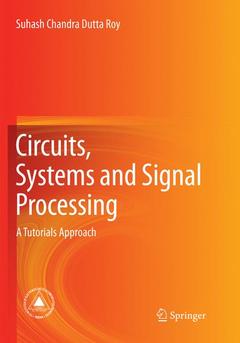Description
Circuits, Systems and Signal Processing, 1st ed. 2018
A Tutorials Approach
Language: English
Subjects for Circuits, Systems and Signal Processing:
Publication date: 01-2019
Support: Print on demand
Publication date: 04-2018
320 p. · 17.8x25.4 cm · Hardback
Description
/li>Contents
/li>Biography
/li>Comment
/li>
Section I: Signals and Systems.- 1. Basic Concepts in Signals and Systems.- 2. The Mysterious Impulse Function and Its Mysteries.- 3. State Variables – Part I.- 4. State Variables – Part II.- 5. Carry Out Partial Fraction Expansion of Functions with Repeated Poles.- 6. A Very Simple Method of Finding the Residues at Repeated Poles of a Rational Function in z–1.- Section II: Passive Circuits.- 7. Circuit Analysis without Transforms.- 8. Transient Response of RLC Networks Revisited.- 9. Appearances can be Deceptive: A Circuit Paradox.- 10. Appearances can be Deceptive- An Initial Value Problem.- 11. Resonance.- 12. The Many Faces of the Single Tuned Circuit.- 13. Analyzing the Parallel-T RC Network.- 14. Design of Parallel-T Resistance Capacitance Networks for Maximum Selectivity.- 15. Perfect Transformer, Current Discontinuity and Degeneracy.- 16. Analytical Solution to the Problem of Charging a Capacitor through a Lamp.- 17. Difference Equations, z-Transforms and Resistive Ladders.- 18. A Third Order Driving Point Synthesis Problem.- 19. Interference Rejection in a UWB System: An Example of LC Driving Point Synthesis.- 20. Low Order Butterworth Filters: From Magnitude to Transfer Function.- 21. Band-Pass/Band-Stop Filter Design by Frequency Transformation.- 22. Optimum Passive Differentiators.- Section III: Active Circuits.- 23. Amplifier Fundamentals.- 24. Appearances can be Deceptive: The Case of a BJT Biasing Circuit.- 25. BJT Biasing Revisited.- 26. Analysis of a High Frequency Transistor Stage.- 27. Transistor Wien Bridge Oscillator.- 28. Analyzing Sinusoidal Oscillator Circuits: A Different Approach.- 29. Triangular to Sine Wave Converter.- 30. Dynamic Output Resistance of the Wilson Current Mirror.- Section IV: Digital Signal Processing.- 31. The ABCD’s of Digital Signal Processing (Part 1).- 32. The ABCD’s of Digital Signal Processing (Part 2).- 33. On Second Order Digital Band-Pass and Band-Stop Filters.- 34. Derivation of Second Order Canonic All-Pass Digital Filter Realizations.- 35. Derivation of the FIR Lattice Structure.- 36. Solution to a Problem in FIR Lattice Synthesis.- 37. FIR Lattice Structures with Single Multiplier Sections.- 38. A Note on the FFT.- Appendix : Some Mathematical Topics Simplified.- A.1. A Semi-Analytical Method for Finding the Roots of a Polynomial.- A.2. A Fresh Look at the Euler’s Relation.- A.3. Approximating the Square Root of the Sum of Two Squares .- A.4. On the Solution of Quartic and Cubic Equations.- A.5. Many Ways of Solving an Ordinary Linear Second Order Differential Equation with Constant Coefficients.- A.6. Proofs of Two Chebyshev Polynomial Identities Useful in Digital Filter Design.- A.7. Computation of the Coefficients of Chebyshev Polynomials .- Sources.




